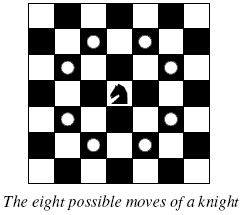POJ2488——DFS——A Knight's Journey
Description
 Background
Background
The knight is getting bored of seeing the same black and white squares again and again and has decided to make a journey
around the world. Whenever a knight moves, it is two squares in one direction and one square perpendicular to this. The world of a knight is the chessboard he is living on. Our knight lives on a chessboard that has a smaller area than a regular 8 * 8 board, but it is still rectangular. Can you help this adventurous knight to make travel plans?
Problem
Find a path such that the knight visits every square once. The knight can start and end on any square of the board.
Input
The input begins with a positive integer n in the first line. The following lines contain n test cases. Each test case consists of a single line with two positive integers p and q, such that 1 <= p * q <= 26. This represents a p * q chessboard, where p describes how many different square numbers 1, . . . , p exist, q describes how many different square letters exist. These are the first q letters of the Latin alphabet: A, . . .
Output
The output for every scenario begins with a line containing "Scenario #i:", where i is the number of the scenario starting at 1. Then print a single line containing the lexicographically first path that visits all squares of the chessboard with knight moves followed by an empty line. The path should be given on a single line by concatenating the names of the visited squares. Each square name consists of a capital letter followed by a number.
If no such path exist, you should output impossible on a single line.
If no such path exist, you should output impossible on a single line.
Sample Input
3 1 1 2 3 4 3
Sample Output
Scenario #1: A1 Scenario #2: impossible Scenario #3: A1B3C1A2B4C2A3B1C3A4B2C4
Source
TUD Programming Contest 2005, Darmstadt, Germany
大意:一个骑士从原点出发,只能走马字型路线, 要求遍历所有路径的字典序排序(就是先A再B再C),用DFS思想遍历每一种状态,如果最后步数等于图的大小那么就直接输出,难在字典序排序(虽然还不知道为什么这样写dir这个数组- -||),用visit记录已经经过的点,最后如果DFS失败那么visit要重新变成0

#include<cstdio> #include<cstring> using namespace std; const int inf = 27; int visit[inf][inf]; int dir[8][2] = {{-1,-2},{1,-2},{-2,-1},{2,-1},{-2,1},{2,1},{-1,2},{1,2}}; int flag ,p, q,ans; struct edge{ char s; int num; }a[inf*inf]; void dfs(int x,int y,int step) { if(flag == 0 ) return ; if(visit[x][y]) return ; visit[x][y] = 1; if(step == ans){ flag = 0; for(int i = 1; i <= ans;i++) printf("%c%d",a[i].s,a[i].num); printf("\n"); return ; } for(int i = 0; i < 8 ; i++){ int x1 = x + dir[i][0]; int y1 = y +dir[i][1]; if( x1 < 1||y1 < 1||x1 >p||y1 > q||visit[x1][y1] == 1) continue; a[step+1].s = 'A' + y1 - 1; a[step+1].num = x1; dfs(x1,y1,step+1); visit[x1][y1] = 0; } } int main() { int T,count = 1; scanf("%d",&T); while(T--){ memset(visit,0,sizeof(visit)); flag = 1; a[1].s = 'A',a[1].num = 1; scanf("%d%d",&p,&q); ans = p*q; printf("Scenario #%d:\n",count++); dfs(1,1,1); if(flag == 1) printf("impossible\n"); if(T!=0) printf("\n"); } return 0; }
